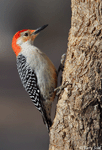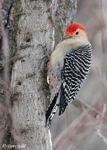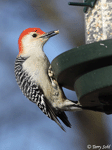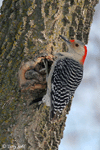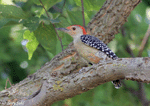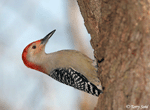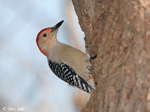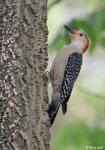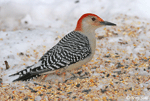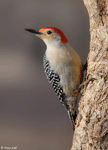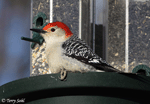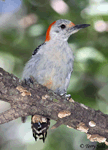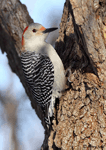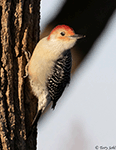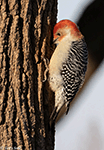| Length: 9 - 10 inches | Wingspan: 15 - 18 inches | Seasonality: All Seasons |
| ID Keys: Red stripe on back of head, black and white barring on back. Red-washed belly usually very hard to see. | ||
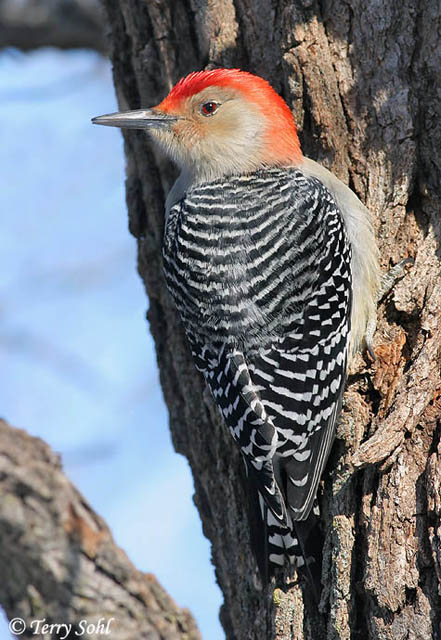 The Red-bellied Woodpecker
is an often noisy bird that has
adapted to living in residential areas and parks. Despite the name, it's
usually very difficult to see the reddish wash on the belly. The red
stripe on it's head is a much more obvious identification feature. The red on
the head extends all the way from the forehead to nape on males, while the
females only have red on the nape.
The Red-bellied Woodpecker
is an often noisy bird that has
adapted to living in residential areas and parks. Despite the name, it's
usually very difficult to see the reddish wash on the belly. The red
stripe on it's head is a much more obvious identification feature. The red on
the head extends all the way from the forehead to nape on males, while the
females only have red on the nape.
Habitat:
Floodplain forests, woodlands, groves, orchards, towns.
Diet:
Omnivorous. Eats many insects, but plant material may make up half the diet in some seasons.
Behavior:
Foraging primarily occurs while climbing on tree trunks and branches in search of insects. They will also fly out from perches to catch insects in flight. During parts of the near, seeds, nuts, and fruit can make up a significant portion of the diet. They nest in cavities, often competing for the same nesting cavities as non-native species such as the European Starling.
Nesting:
May and June. The nest of a Red-bellied Woodpecker is a cavity they themselves excavate in a tree, or sometimes in a man-made object like a fence post or telephone pole. The female usually lays 4 or 5 eggs, and both parents help to incubate them. When the eggs hatch, both parents help to feed the young. The young fledge after 3 or 4 weeks, but typically remain near the parents for several weeks after fledging.
Song / Vocalizations:
Often very vocal birds, Red-bellied Woodpeckers have multiple calls, including a rattling call from the males and hoarse, raspy contact calls. Their drumming is also a commonly heard sound where they are present.
- Click here to hear short single-note calls of a male Red-bellied Woodpecker1
- Click hear to hear the rattling, rolling calls of a Red-bellied Woodpecker2
- Click here to hear the drumming of a Red-bellied Woodpecker3
Migration:
Not migratory, although some wander in the fall, especially juveniles.
Interactive eBird Map:
Click here to access an interactive eBird map of Red-bellied Woodpecker sightings
Similar Species:
With the strong ladder-backed pattern, larger size than many woodpeckers, and distinctive red crest, the Red-bellied Woodpecker is unlikely to be confused with another species if seen within the borders of South Dakota. Outside of the state, they may be confused with the following (in the proper ranges):
- Golden-fronted Woodpecker - The Golden-fronted Woodpecker has a more restricted range in the United States than the Red-bellied Woodpecker, only being found in Texas and southern Oklahoma, as well as southward through Mexico into Central America. They share the same structure and plumage patterns on their back and undersides, but the head on a Golden-fronted Woodpecker has a yellow nape and forehead, with a red spot on the top of the male's head. The underside has a splash of yellow rather than the (often difficult to see) reddish tones on a Red-bellied Woodpecker.
- Gila Woodpecker - The Gila Woodpecker has a similar overall appearance to the Red-bellied Woodpecker, although the red on the head is much less extensive. The ranges of the two species don't overlap, however, with Gila Woodpeckers being found in the desert Southwest.
- Ladder-backed Woodpecker - There is a small area of potential range overlap between the Ladder-backed Woodpecker and the Red-bellied Woodpecker, in Texas. From a distance both ahve black and white barring on the back, lighter undersides, and red on the head. However, the Ladder-backed Woodpecker is considerably smaller than the Red-bellied Woodpecker, has a strong facial pattern lacking on the Red-bellied Woodpecker, and exhibits spotting on the flanks that's lacking on a Red-bellied Woodpecker.
- Red-headed Woodpecker - A woodpecker with substantial range overlap with the Red-bellied Woodpecker, the Red-headed Woodpecker may be primarily confused with the Red-bellied Woodpecker because of the name! They do share the traits of a darker back, lighter underparts, and red on the head. However, the back of a Red-headed Woodpecker is a solid black without the barring found on a Red-bellied Woodpecker. The head is entirely red (and a darker red) compared to the more orangish-red "crest" stripe of a Red-bellied Woodpecker. The Red-headed Woodpecker also has a bold white wing patch and bright white underparts that are lacking on a Red-bellied Woodpecker.
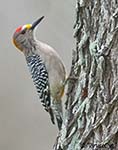 |
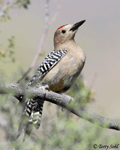 |
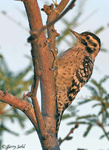 |
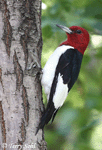 |
| Golden-fronted Woodpecker | Gila Woodpecker | Ladder-backed Woodpecker | Red-headed Woodpecker |
Feeders:
Nuts, sunflower seeds, peanut butter, and suet
Conservation Status:
Seems to be increasing and extending it's range to the north. However, it has undoubtedly suffered in some areas due to competition with European Starlings for nesting sites. The IUCN currently lists the Red-bellied Woodpecker as a species of "Least Concern".
Further Information:
- National Geographic - Red-bellied Woodpecker
- WhatBird - Red-bellied Woodpecker
- Audubon Guide- Red-bellied Woodpecker
Photo Information: November 30th, 2007 - Big Sioux Recreation Area near Brandon, South Dakota - Terry Sohl
Additional Photos:
Click on the image chips or text links below for additional, higher-resolution Red-bellied Woodpecker photos.
Audio File Credits:
- 1Will Sweet. Recorded in Barnstable County, Massachusetts on January 29th, 2020. Original file and information from xeno-canto.
- 2Eric DeFonso. Recorded in Riley County, Kansas on May 12th, 2017. Original file and information from xeno-canto.
- 3Jim Berry. Recorded in Chautauqua County, New York on April 23rd, 2016. Original file and information from xeno-canto.
| Click on the map below for a higher-resolution view |
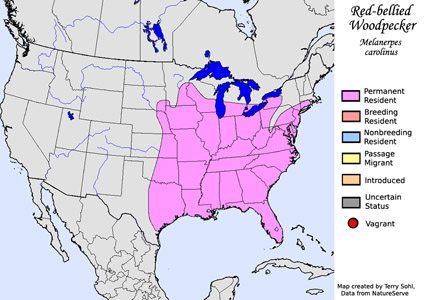 |
| South Dakota Status: Uncommon permanent resident in the eastern half of the state, casual in the west. |
Additional Red-bellied Woodpecker Photos
Click for a higher-resolution version of these photos
